Contents
Planting and caring for perennial morning glory is easy to perform, which is suitable even for beginner gardeners. A vine-type plant takes the form of a support offered to it. Grow a crop for vertical gardening, in pots and as a groundcover. The climbing perennial liana is distinguished by decorative and delicate flowering and a large amount of green mass.
General description of the plant
Ipomoea perennial is a herbaceous vine belonging to the Bindweed family. It also has a name – fabritis. It is characterized by strong branching and fast growth of creeping stems.
The leaves are most often large, heart-shaped, opposite or alternate on the stem. The foliage has a slight wrinkling, long petioles. The foliage is dense.
Funnel-shaped flowers, simple or double, 5-12 cm in diameter. Varied colors:
- white;
- purple;
- pink;
- blue;
- with a combination of two or more shades.
The edges of the petals are smooth or wavy. Many species exude a delicate aroma.
The peculiarity of the flowering of most varieties is the opening of flowers in the early morning and closing them in bright sun. In cloudy weather, perennial morning glory can be revealed throughout the day. Flowering continues until late autumn. The culture is unpretentious in cultivation. In the photo below, with proper planting and proper care of perennial morning glory, you can observe lush flowering.
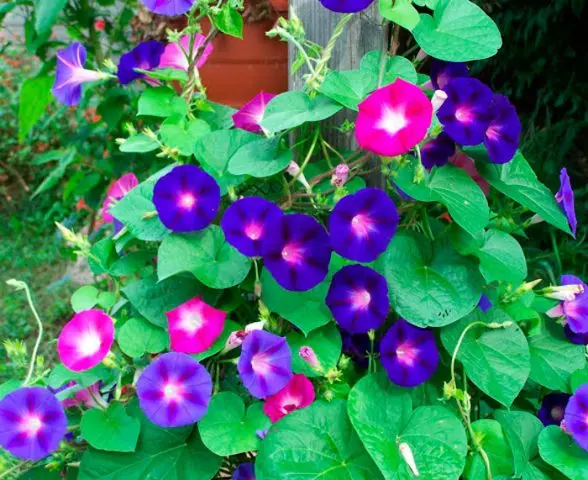
Seeds in the fruit box appear at the end of summer. Perennial liana can reproduce by self-seeding. Seed germination lasts 2-4 years.
Ipomoea perennial unpretentious to the composition of the soil. It does not tolerate open sunny areas and needs constant watering. Requires support. When used as a border plant, constant shortening of the shoots is necessary.
Varieties
In the wild, the perennial morning glory grows in a subtropical climate and has about 500 varieties. Two types of herbaceous plants are edible – aquatic spinach (more popular in Asian countries) and sweet potato, which forms edible tubers. About 20 varieties are used in horticulture.
moonflower
Ipomoea moonflowering has been grown for about 200 years. It is distinguished by large white flowers, about 10-12 cm in diameter. White morning glory is a nocturnal plant, the flowering of which begins in the evening and continues until early morning. The flowers have a pleasant aroma of almonds and have a shimmering effect. Flowers may remain open on cloudy days. Each flower lives for one day. The liana is highly branched, the lateral shoots are long, the leaves are large, creating a dense, opaque carpet.

The stems of the creeper grow up to 3 m, and the shoots can reach 6 m. Flowering begins in mid-summer or August and continues until October. It differs from other species in the good survival rate of layering during reproduction.
Purple
One of the most familiar and popular types for cultivation. The liana is long, reaches 8 m. The stems are slightly pubescent, the leaves are oval or oblong in shape, arranged oppositely. Flowers grow 7 cm in diameter, collected in clusters. Natural color is purple. Breeding method bred varieties with a variety of shades:
- red;
- pink;
- purple;
- dark purple.
With and without edging, as well as with different colors of the middle.
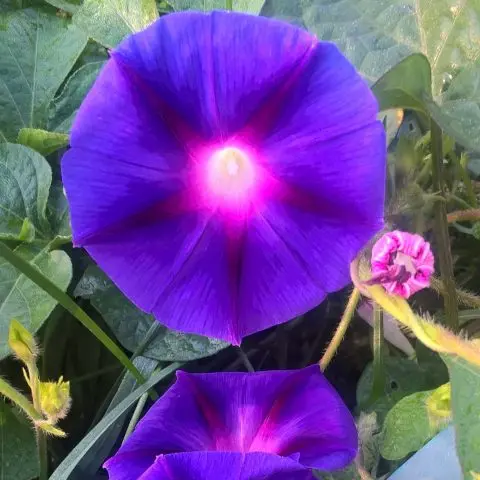
Popular varieties of the purple variety of morning glory:
- scarlet Scarlett O’Hara;
- rich purple Gypsy;
- raspberry Caprice;
- blue Giselle.
The number of varieties is constantly increasing. It has been known in cultivation for over 300 years.
Tricolor
The tricolor variety has been grown since 1830. The length of the shoots is 4-5 m, the leaves are heart-shaped, arranged oppositely. Flowers – 8-10 cm in diameter, are formed in bunches. The flowers of the red-blue variety of morning glory change color during the life cycle. They bloom with a blue tint, and withering become pink.
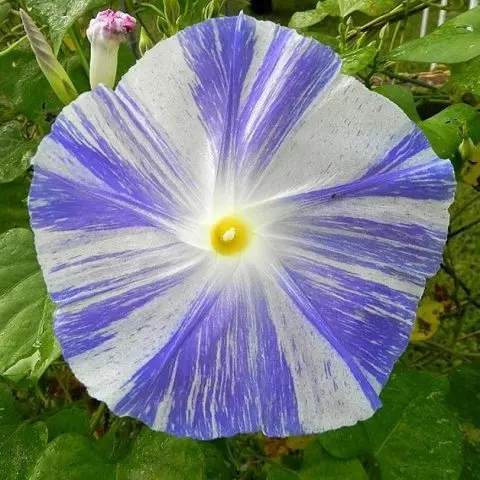
Variety Paradise butterflies has a mixture of pink and burgundy shades. Variety Flying saucer is distinguished by large-sized flowers. The color of the variety is characterized by light blue uneven stripes on a white background. Each flower has a unique pattern and a delicate aroma. The Sky Blue Ipomoea variety was awarded the prize of the Royal Horticultural Society of Great Britain. The variety has a delicate blue tint.
Cairo
Cairo Ipomoea is distinguished by original leaves that have a palmate shape. Bright green leaves are arranged transversely and have 5-7 lobes. Tuberous root. The stems are bare, grow up to 5 m long.

The main color is lilac, purple-pink. Less common is a white shade with a contrasting dark center. Numerous flowers grow singly or in small groups. They are small in size – 5-6 cm in diameter. The species is characterized by strong branching and rapid growth.
Neil
Ipomoea Nile for decorating gardens is widespread in Japan, where it is called Asagao. Liana grows 2,5-3 m in size, the stem forms a strong, flowers – 7-10 cm. The leaves are oval, wide, with long petioles, dark green in color. The foliage is dense, forming a dense carpet. Photos of the perennial Ipomoea Nile illustrate the variety of flower shapes that come with different edge relief and terry.
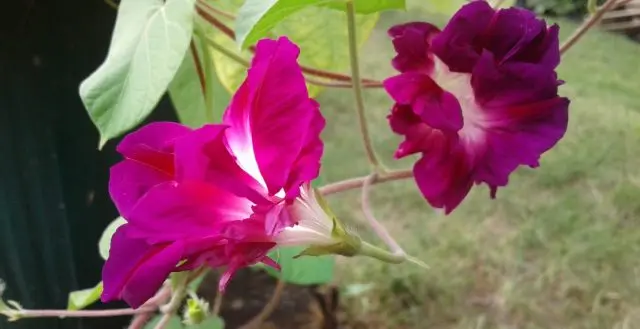
Bells of the Pikoti variety are blue and red with white edging and a little terry. The Serenade variety is distinguished by terry cherry-red gramophones. Variety Chocolate has an original color of brown and dusty pink. The variety has a longer period when the flower is open.
Kvamoklit
Ipomoea Kvamoklit is distinguished by small star-shaped flowers. The dominant color is red. Kvamoklit blooms during the day and rolls up in the evening, unlike other varieties. Liana forms a short, long – from 1,5 to 3,5 m. Kvamoklit has several subspecies with different leaf shapes.
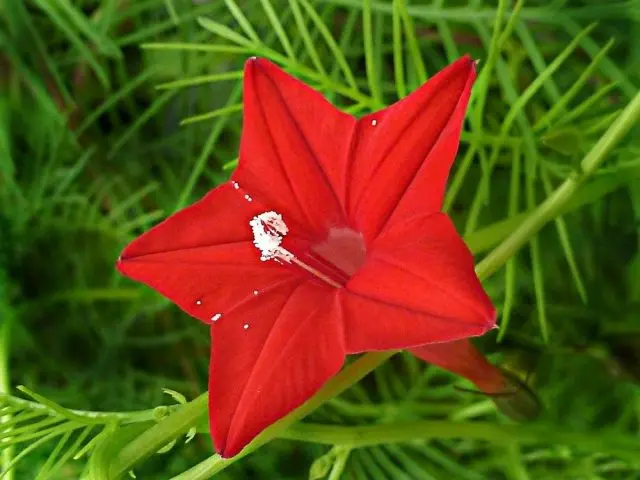
The leaves of some varieties have a characteristic heart-shaped shape. Other species have original pinnate leaves. They are dissected into small segments, resembling needles. At the base of the plant, the leaves grow larger than at the top.
Perennial ipomoea is a poisonous plant. The seeds of some varieties contain psychotropic and toxic substances.
Breeding methods
Ipomoea is propagated by seed. Seeds with flowers of various shades are chosen in specialized stores. Also, perennial morning glory reproduces well by self-sowing, but without causing trouble to the gardener.
Planting perennial morning glory
Planting morning glory perennial is possible in seedling and seedless way. Before sowing, the seeds are soaked for several days. It is sown in open ground when a constant temperature is established from + 15 ° C and above. Sow several pieces in one nest, deepening by 1-2 cm. The distance between the nests is 20-25 cm.
Ipomoea is recommended to be planted in sunny, calm places. The soil for planting should be loose, permeable. Shoots appear in 5-7 days. Excessively elongated seedlings can be slightly deepened. From the very beginning of growth, bindweeds need to be supported.
Aftercare
Ipomoea perennial must be watered with warm water once every few days. Top dressing is more favorable to produce fertilizers for flowers, but without an overabundance. Highly nutritious soil provokes an increase in leaf mass with small flowering.
Trimming
Pruning is done to limit growth, if necessary. It is also carried out to give various forms to the plant, as well as when used as a ground cover crop. The plant treats pruning favorably.
Preparation for winter
Ipomoea perennial frost resistance does not differ, so the vine is cut for the winter. For storage at room conditions, it can be transplanted into pots.
Fighting diseases and pests
Perennial morning glory can be affected by spider mites and aphids. To get rid of insects, vines are sprayed with water or insecticides in case of a large affected area.
Diseased plants are removed, fungicides are used to disinfect the soil and healthy vines.
Application in the design of the site
Ipomoea perennial is used for decorative purposes for vertical landscaping. A climbing plant can be planted along arches and pergolas, cones, decorate gazebos, and make green fences. Ipomoea perennial will quickly disguise old and outbuildings. Plants can be guided or trimmed to the desired shape.
Ipomoea perennial in the design of the site is combined with:
- sweet peas;
- decorative beans;
- kampsis;
- hops;
- wild grapes.
In flower beds, Ipomoea sweet potato is planted with petunias, pelargoniums and coleus. Ipomoea can be transplanted from pots into open ground at any time. Ipomoea perennial is not recommended to be planted next to photophilous plants.
Conclusion
Planting and caring for perennial morning glory do not cause trouble for gardeners. Seeds can be planted by direct sowing in the ground. For care, you need to create a support and constant watering. With the help of climbing vines with delicate flowering and large foliage, you can create various decorative solutions and shaded corners.









